Biomechanical Analysis of Gait in Forestry Environments: Implications for Movement Stability and Safety
Abstract
1. Introduction
1.1. Related Studies and Scientific Papers
1.2. Introduction to the Current Study
2. Materials and Methods
2.1. Participants
2.2. Measurement Methods
2.3. Measurement Environment
2.4. Gait Data Collection and Recording
2.5. Gait Data Analysis
- General Parameters (such as walking speed, number of steps, cadence, walking duration, walking distance, and total step distance);
- Graphical outputs included:
- Hip, knee, ankle, and pelvis motion patterns;
- Foot progression angle;
- Center-of-mass tracking.
- Number of Steps—Total steps taken; higher counts over short distances suggest shorter steps, linked to balance or efficiency.
- Walking Duration—Total time is taken; longer durations may reflect fatigue or instability.
- Step Speed—Speed of each step; faster speeds aid momentum but may reduce stability, while slower speeds can signal motor control issues.
- Step Cadence—Steps per minute; higher cadence can indicate better control but may increase fall risk if excessive.
- Foot Strike Heel—Heel–ground contact during the initial strike; proper contact supports shock absorption and balance.
- Foot Strike Toe—Toe contact during push-off is crucial for propulsion and forward movement.
- Step Width—Lateral distance between steps; wider width enhances stability but may signal balance compensation.
- Step Length—Distance between consecutive footfalls; short steps may imply caution or instability.
- Stride Length—Distance between successive steps of the same foot; reflects walking efficiency and overall stability.
- We also analyzed the interrelations between parameters and their influence on gait stability [9,14,19,26]:
- ○
- Step Speed and Step Cadence—A controlled cadence with stable speed promotes balance; irregularities can cause instability.
- ○
- Step Width and Step Length—Optimal width supports balance; too narrow or too wide may indicate instability.
- ○
- Foot Strike Heel and Toe—A smooth transition between heel strike and toe-off is vital for continuous, safe walking.
- ○
- Stride Length and Walking Duration—A shorter stride often leads to a longer duration, suggesting reduced mobility or impaired coordination.
2.6. Data Analysis and Statistical Methods
- Surface (solid, trail, and forest);
- Walk Order (first walk vs. subsequent walk);
- Gender (male and female);
- Shoe size (continuous);
- Interaction effects among the above-listed.
- Number of steps;
- Walking duration;;
- Step speed
- Cadence;
- Foot strike—heel;
- Foot strike—toe;
- Step width;
- Step and stride length.
3. Results
3.1. Gait Data Analysis and Statistics
- Repeated exposure to specific terrains prompts subtle adaptations in locomotor patterns, reflecting motor learning and neuromuscular plasticity.
- However, prolonged or repeated strain on neuro-motor control systems may lead to fatigue or altered gait characteristics, potentially diminishing efficiency or stability over time.
- Solid vs. Trail: A statistically significant difference was found (p = 0.003, adjusted p = 0.010), indicating that gait mechanics on solid surfaces differ meaningfully from those on trails.
- Solid vs. Forest: A highly significant difference was observed (p < 0.001), with the largest test statistic (−77.592), suggesting substantial gait variation between walking on solid ground and forest terrain.
- Trail vs. Forest: This comparison also showed a significant difference (p < 0.001), with a test statistic of −50.100, indicating meaningful biomechanical adaptation even between moderately stable trail surfaces and more irregular forest terrain.
3.1.1. Distribution of Pelvis Positioning (Figure 12)
- Increased lateral or rotational shifts may reflect gait asymmetry, muscular weakness, or compensatory strategies triggered by surface instability or structural imbalance.
- Excessive pelvic tilt or deviation can suggest postural misalignment, lower back dysfunction, or underlying mobility impairments.
- Uneven pelvic movement patterns may be attributed to terrain variability or musculoskeletal conditions affecting gait control.
3.1.2. Distribution of Center of Mass (CoM) Positioning (Figure 13)
- A narrow and controlled CoM distribution reflects effective weight transfer, strong postural control, and efficient locomotor mechanics.
- High variability or excessive shifts in CoM position suggest impaired balance control, reduced adaptability to terrain, or instability during walking.
- Irregular CoM movement patterns may be associated with an elevated risk of falls, particularly in individuals with neurological disorders, musculoskeletal impairments, or compromised motor control.
4. Discussion
4.1. Summary of Gait Adaptation Results
- Fewer steps and shorter walking duration;
- Consistent walking speed (1.10 m/s);
- Cadence of 103.30 steps/min;
- High percentage of heel strikes (99.68%);
- Minimal variability in step width and stride length.
- Increased step count (24.70) and cadence (107.56 steps/min);
- Slightly higher speed (1.24 m/s);
- Greater variability in step width (5.72 cm) and step length (4.92 cm);
- Decreased heel strikes (94.28%) with increased toe strikes (5.72%).
- Highest step count (27.93) and longest duration (16.97 s);
- Reduced speed (1.17 m/s) and cadence (100.10 steps/min);
- Further increases in step width variability (0.63 cm) and step length variability (5.77 cm);
- Significant drop in heel strikes (80.59%) and rise in toe strikes (19.41%);
- Increased stride length variability (0.24 cm).
- Step width, step length, and foot placement patterns varied significantly with terrain type.
- Participants showed greater step width and foot strike variability on forest trails and forest environments than on solid surfaces.
- On solid ground, gait was consistent, with near-total reliance on heel strikes.
- On forest trails, step width and cadence increased moderately to accommodate irregular ground.
- In forest environments, participants exhibited:
- ○
- Larger step width adjustments;
- ○
- More frequent toe strikes;
- ○
- Increased stride asymmetry;
- ○
- Decreased cadence indicating more cautious movement strategies.
- The shift from heel-strike dominance on solid surfaces to increased toe engagement in forest environments reflects an adaptive response aimed at preventing slips on unstable ground.
- Participants spent more time in foot–ground contact in forest environments, signaling cautious behavior to reduce missteps.
- Gait became more irregular, with wider steps and more variable cadence, hallmarks of reduced coordination and increased neuromuscular demand.
- These changes suggest that walking on forest terrain increases fall risk, especially under conditions of fatigue or impaired balance.
4.2. Study Insights and Future Directions
5. Conclusions
Author Contributions
Funding
Institutional Review Board Statement
Informed Consent Statement
Data Availability Statement
Acknowledgments
Conflicts of Interest
References
- US National Safety Council. Occupational Safety Highlights. 2022. Available online: https://injuryfacts.nsc.org/work/work-overview/work-safety-introduction/ (accessed on 10 September 2024).
- Guide to Good Practice in Contract Labour in Forestry; Food and Agriculture Organization of the United Nations: Rome, Italy, 2011; ISBN 978-92-5-106877-9.
- Tsioras, P.A.; Rottensteiner, C.; Stampfer, K.; Tamparopoulos, A.E. Slip, Trip and Fall Accidents in a Large Forest Enterprise; CRC Press: Boca Raton, FL, USA, 2013; ISBN 9780429227714. [Google Scholar]
- Jankovský, M.; Allman, M.; Allmanová, Z. What are the occupational risks in forestry? Results of a long-term study in Slovakia. Int. J. Environ. Res. Public Health 2019, 16, 4931. [Google Scholar] [CrossRef] [PubMed]
- Allman, M.; Dudakova, Z.; Jankovsky, M. Occupational accidents in Slovak Military Forests and Estates: Incidence, timing, and trends over 10 years. Front. Public Health 2024, 12, 1369948. [Google Scholar] [CrossRef]
- Okuda, M.; Kawamoto, Y.; Tado, H.; Fujita, Y.; Inomata, Y. Energy Expenditure Estimation for Forestry Workers Moving on Flat and Inclined Ground. Forests 2023, 14, 1038. [Google Scholar] [CrossRef]
- Rhee, K.Y.; Choe, S.W.; Kim, Y.S.; Koo, K.H. The trend of occupational injuries in Korea from 2001 to 2010. Saf. Health Work 2013, 4, 63–70. [Google Scholar] [CrossRef]
- Landekić, M.; Bačić, M.; Bakarić, M.; Šporčić, M.; Pandur, Z. Working Posture and the Center of Mass Assessment While Starting a Chainsaw: A Case Study among Forestry Workers in Croatia. Forests 2023, 14, 395. [Google Scholar] [CrossRef]
- Hawkins, K.A.; Clark, D.J.; Balasubramanian, C.K.; Fox, E.J. Walking on uneven terrain in healthy adults and the implications for people after stroke. NeuroRehabilitation 2017, 41, 765–774. [Google Scholar] [CrossRef] [PubMed] [PubMed Central]
- Thies, S.B.; Richardson, J.K.; Ashton-Miller, J.A. Effects of surface irregularity and lighting on step variability during gait: A study in healthy young and older women. Gait Posture 2005, 22, 26–31. [Google Scholar] [CrossRef] [PubMed]
- Kent, J.A.; Sommerfeld, J.H.; Mukherjee, M.; Takahashi, K.Z.; Stergiou, N. Locomotor patterns change over time during walking on an uneven surface. J. Exp. Biol. 2019, 222, jeb202093. [Google Scholar] [CrossRef]
- Voloshina, A.S.; Kuo, A.D.; Daley, M.A.; Ferris, D.P. Biomechanics and energetics of walking on uneven terrain. J. Exp. Biol. 2013, 216, 3963–3970. [Google Scholar] [CrossRef]
- Gates, D.H.; Wilken, J.M.; Scott, S.J.; Sinitski, E.H.; Dingwell, J.B. Kinematic strategies for walking across a destabilizing rock surface. Gait Posture 2012, 35, 36–42. [Google Scholar] [CrossRef]
- Blair, S.; Lake, M.J.; Ding, R.; Sterzing, T. Magnitude and variability of gait characteristics when walking on an irregular surface at different speeds. Hum. Mov. Sci. 2018, 59, 112–120. [Google Scholar] [CrossRef] [PubMed]
- Shaikh, U.Q.; Shahzaib, M.; Shakil, S.; Bhatti, F.A.; Saeed, M.A. Robust and adaptive terrain classification and gait event detection system. Heliyon 2023, 9, e21720. [Google Scholar] [CrossRef] [PubMed]
- Liu, C.; Downey, R.J.; Salminen, J.S.; Rojas, S.A.; Richer, N.; Pliner, E.M.; Hwang, J.; Cruz-Almeida, Y.; Manini, T.M.; Hass, C.J.; et al. Electrical Brain Activity during Human Walking with Parametric Variations in Terrain Unevenness and Walking Speed. Imaging Neurosci. 2023, 2, 551289. [Google Scholar] [CrossRef] [PubMed] [PubMed Central]
- Kowalsky, D.B.; Rebula, J.R.; Ojeda, L.V.; Adamczyk, P.G.; Kuo, A.D. Human walking in the real world: Interactions between terrain type, gait parameters, and energy expenditure. PLoS ONE 2021, 16, e0228682. [Google Scholar] [CrossRef]
- Zhu, C.; Chen, X.; Yi, J. Human Walking Locomotion Data on Solid Ground and Sand. Mendeley Data 2024. Matlab data structure V2. [Google Scholar] [CrossRef]
- Dennerlein, J.T.; Dixon, P.C.; Coppola, S.M.; Li, S.; Hu, B.; Luo, Y. A database of human gait performance on irregular and uneven surfaces collected by wearable sensors. Sci. Data 2020, 7, 219. [Google Scholar] [CrossRef]
- Donelan, J.M.; Kram, R.; Kuo, A.D. Mechanical work for step-to-step transitions is a major determinant of the metabolic cost of human walking. J. Exp. Biol. 2002, 205, 3717–3727. [Google Scholar] [CrossRef] [PubMed]
- Wu, A.R.; Kuo, A.D. Energetic Tradeoffs of Foot-to-Ground Clearance During Swing Phase of Walking; University of Michigan, Ann Arbor, USA USA, 2015. Available online: https://manojsrinivasan.org/dynamic-walking/AbstractsFolder/Wu3_2015_DW.pdf (accessed on 20 April 2025).
- Kuo, A.D. Stabilization of lateral motion in passive dynamic walking. Int. J. Robot. Res. 1999, 18, 917–930. [Google Scholar] [CrossRef]
- Bauby, C.E.; Kuo, A.D. Active control of lateral balance in human walking. J. Biomech. 2000, 33, 1433–1440. [Google Scholar] [CrossRef] [PubMed]
- Bruijn, S.M.; van Dieën, J.H. Control of human gait stability through foot placement. J. R. Soc. Interface 2018, 15, 20170816. [Google Scholar] [CrossRef]
- Holowka, N.B.; Kraft, T.S.; Wallace, I.J.; Gurven, M.; Venkataraman, V.V. Forest terrains influence walking kinematics among indigenous Tsimane of the Bolivian Amazon. Evol. Hum. Sci. 2022, 4, e19. [Google Scholar] [CrossRef] [PubMed]
- Brambilla, C.; Beltrame, G.; Marino, G.; Lanzani, V.; Gatti, R.; Portinaro, N.; Molinari Tosatti, L.; Scano, A. Biomechanical Analysis of Human Gait When Changing Velocity and Carried Loads: Simulation Study with OpenSim. Biology 2024, 13, 321. [Google Scholar] [CrossRef]
- Roggio, F.; Trovato, B.; Sortino, M.; Vecchio, M.; Musumeci, G. Self-selected speed provides more accurate human gait kinematics and spatiotemporal parameters than overground simulated speed on a treadmill: A cross-sectional study. BMC Sports Sci. Med. Rehabil. 2024, 16, 1–12. [Google Scholar] [CrossRef]
- Nohelová, D.; Bizovska, L.; Vuillerme, N.; Svoboda, Z. Gait Variability and Complexity during Single and Dual-Task Walking on Different Surfaces in Outdoor Environment. Sensors 2021, 21, 4792. [Google Scholar] [CrossRef]
- Bergmann, J.; Mayagoitia, R.; Smith, I. A portable system for collecting anatomical joint angles during stair ascent: A comparison with an optical tracking device. Dyn. Med. 2009, 8, 3. [Google Scholar] [CrossRef] [PubMed] [PubMed Central]
- Schepers, M.; Giuberti, M.; Bellusci, G. Xsens MVN: Consistent Tracking of Human Motion Using Inertial Sensing. Xsens Technol. 2018, 1, 1–8. [Google Scholar] [CrossRef]
- Negi, S.; Sharma, S.; Sharma, N. FSR and IMU sensors-based human gait phase detection and its correlation with EMG signal for different terrain walk. Sens. Rev. 2021, 41, 235–245. [Google Scholar] [CrossRef]
- Xsens/Movella Company. Xsens MVN Gait Report: The Use of Inertial Motion Capture for Cloud Based; Document MVN Gait Report—Whitepaper, Revision A, 12 January 2021. Available online: https://www.movella.com/resources/white-papers/white-papers/mvn-gait (accessed on 1 September 2024).
- Xsens/Movella company. Xsens MVN Gait Report: Gait Report—How to interpret the data Document MVN Gait report. Available online: https://base.movella.com/s/article/Gait-Report-How-to-interpret-data?language=en_US (accessed on 1 September 2024).
- Tsay, J.S.; Kim, H.E.; McDougle, S.D.; Taylor, J.A.; Haith, A.; Avraham, G.; Krakauer, J.W.; Collins, A.G.E.; Ivry, R.B. Fundamental processes in sensorimotor learning: Reasoning, refinement, and retrieval. eLife 2024, 13, e91839. [Google Scholar] [CrossRef] [PubMed] [PubMed Central]
- Zhu, C.; Chen, X.; Yi, J. Biomechanical Comparison of Human Walking Locomotion on Solid Ground and Sand. ASME. J. Biomech. Eng. 2025, 147, 041005. [Google Scholar] [CrossRef]
- Hauser, K. Adaptive Locomotion on Uneven Terrains. In Humanoid Robotics: A Reference; Springer: Dordrecht, The Netherlands, 2017. [Google Scholar] [CrossRef]
- Gates, D.H.; Wilken, J.M.; Scott, S.J.; Sinitski, E.H.; Dingwell, J.B. Gait characteristics of individuals with transtibial amputations walking on a destabilizing rock surface. Gait Posture 2012, 36, 33–39. [Google Scholar] [CrossRef]
- Marigold, D.S.; Patla, A.E. Age-related changes in gait for multi-surface terrain. Gait Posture 2008, 27, 689–696. [Google Scholar] [CrossRef] [PubMed]
- Marigold, D.S.; Patla, A.E. Visual information from the lower visual field is important for walking across multi-surface terrain. Exp. Brain Res. 2008, 188, 23–31. [Google Scholar] [CrossRef] [PubMed]
- Bertram, J. Constrained optimization in human walking: Cost minimization and gait plasticity. J. Exp. Biol. 2005, 208, 979–991. [Google Scholar] [CrossRef] [PubMed]
- Harris, E.J.; Khoo, I.H.; Demircan, E. A Survey of Human Gait-Based Artificial Intelligence Applications. Front. Robot. AI 2022, 8, 749274. [Google Scholar] [CrossRef] [PubMed] [PubMed Central]

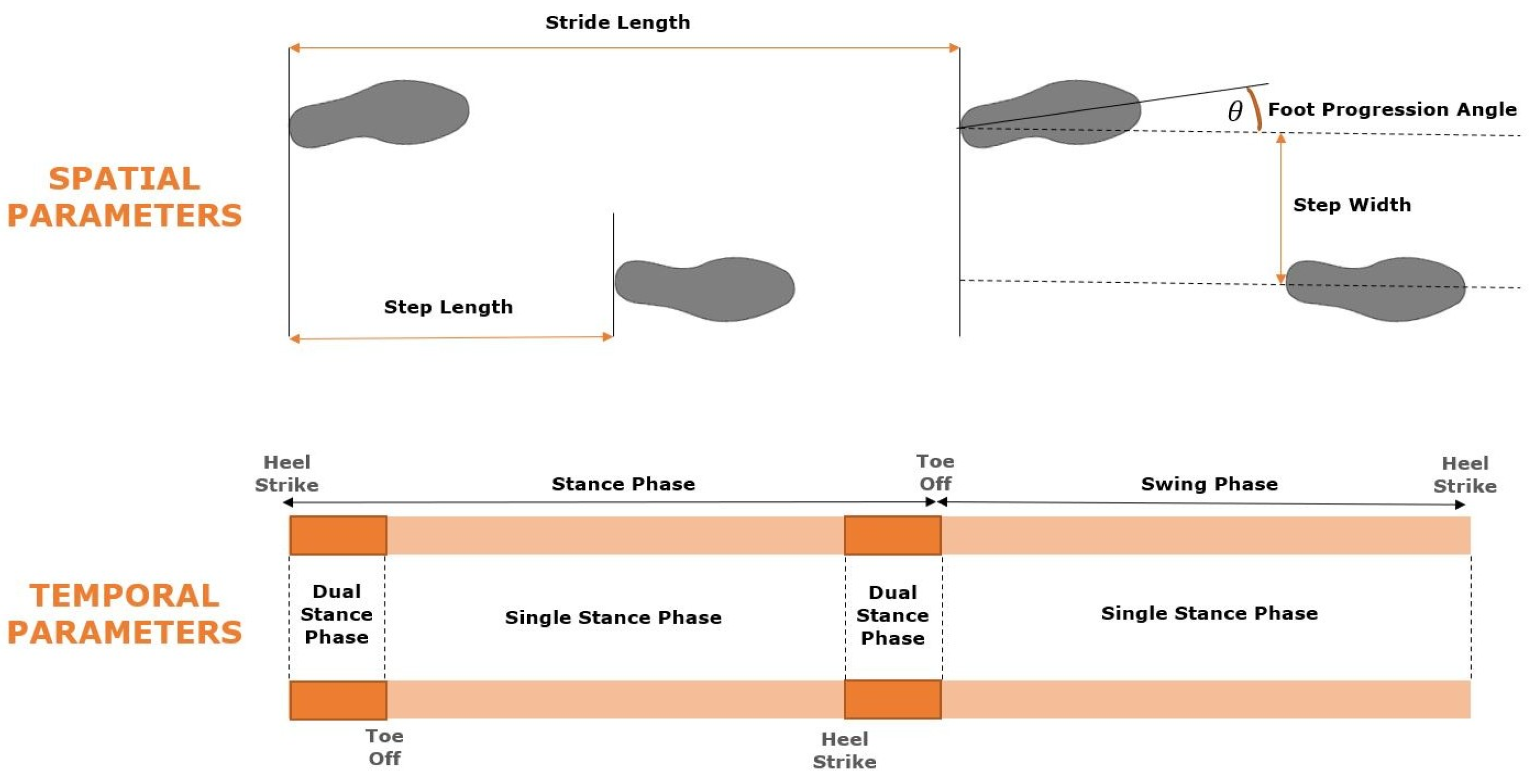
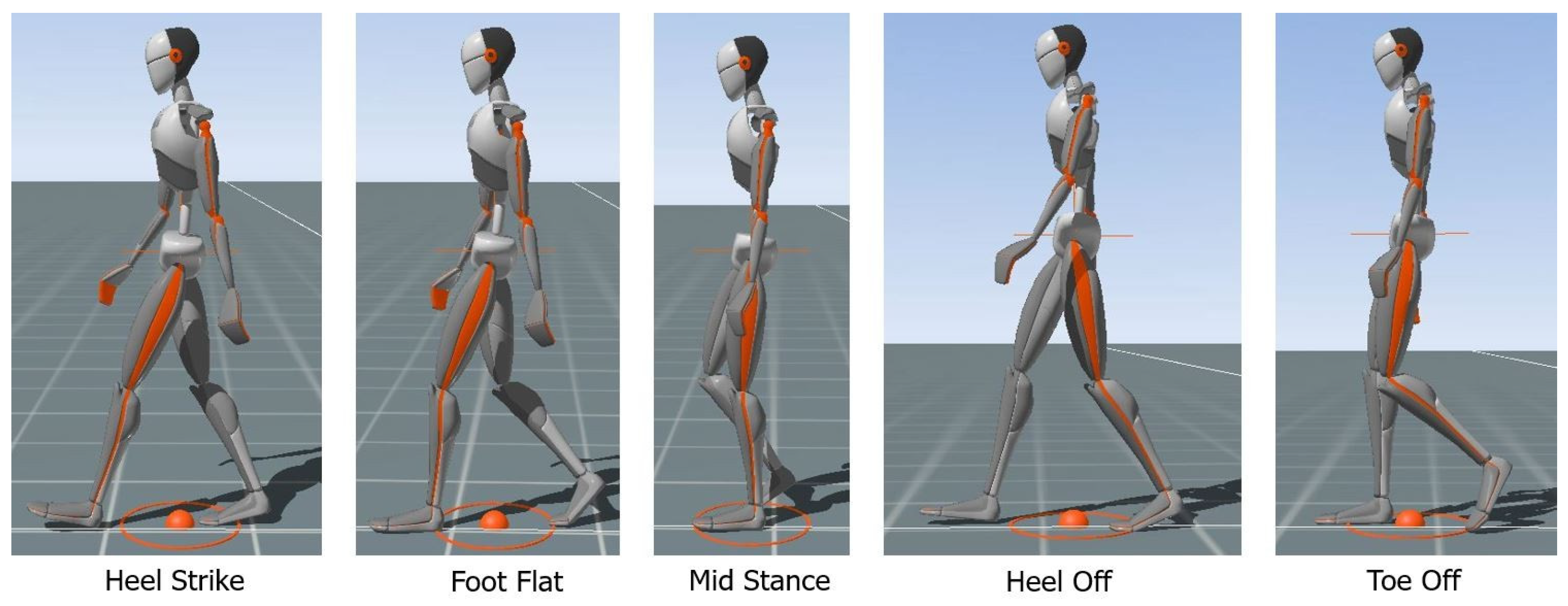


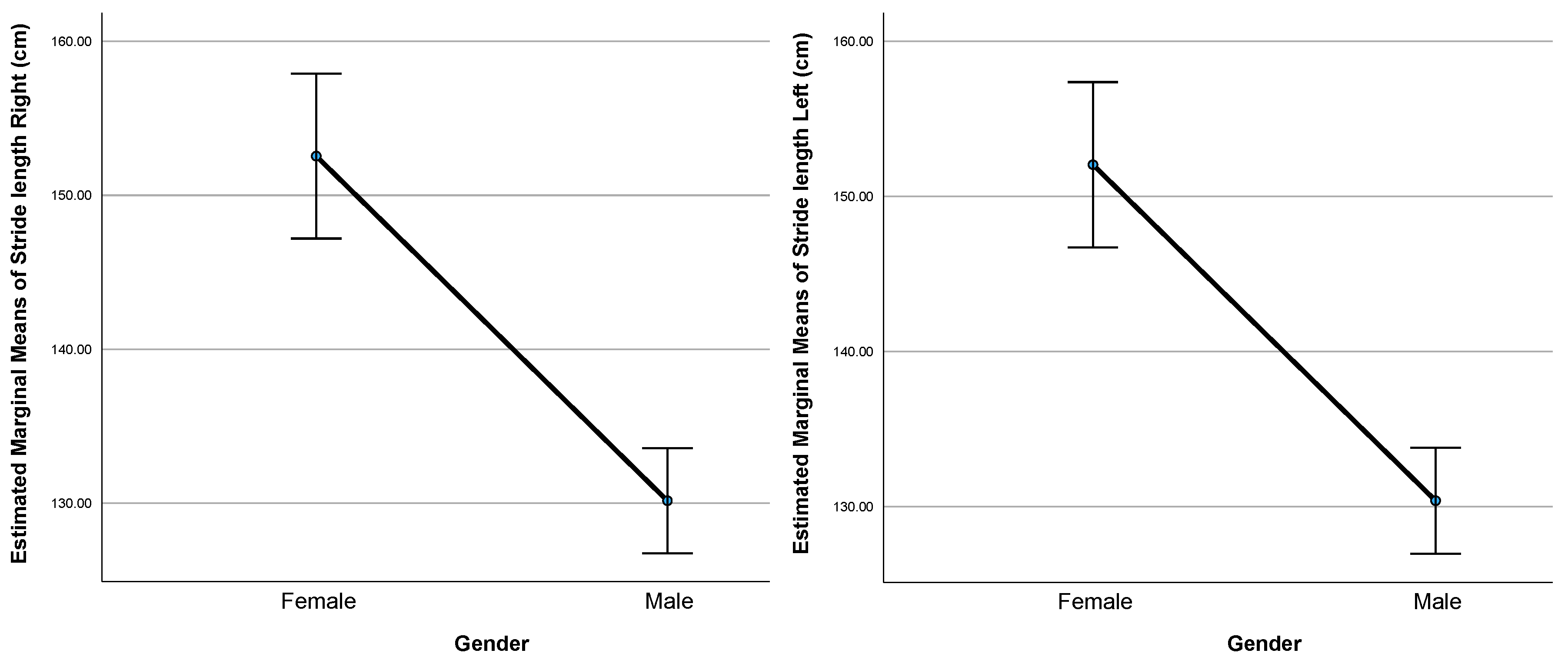
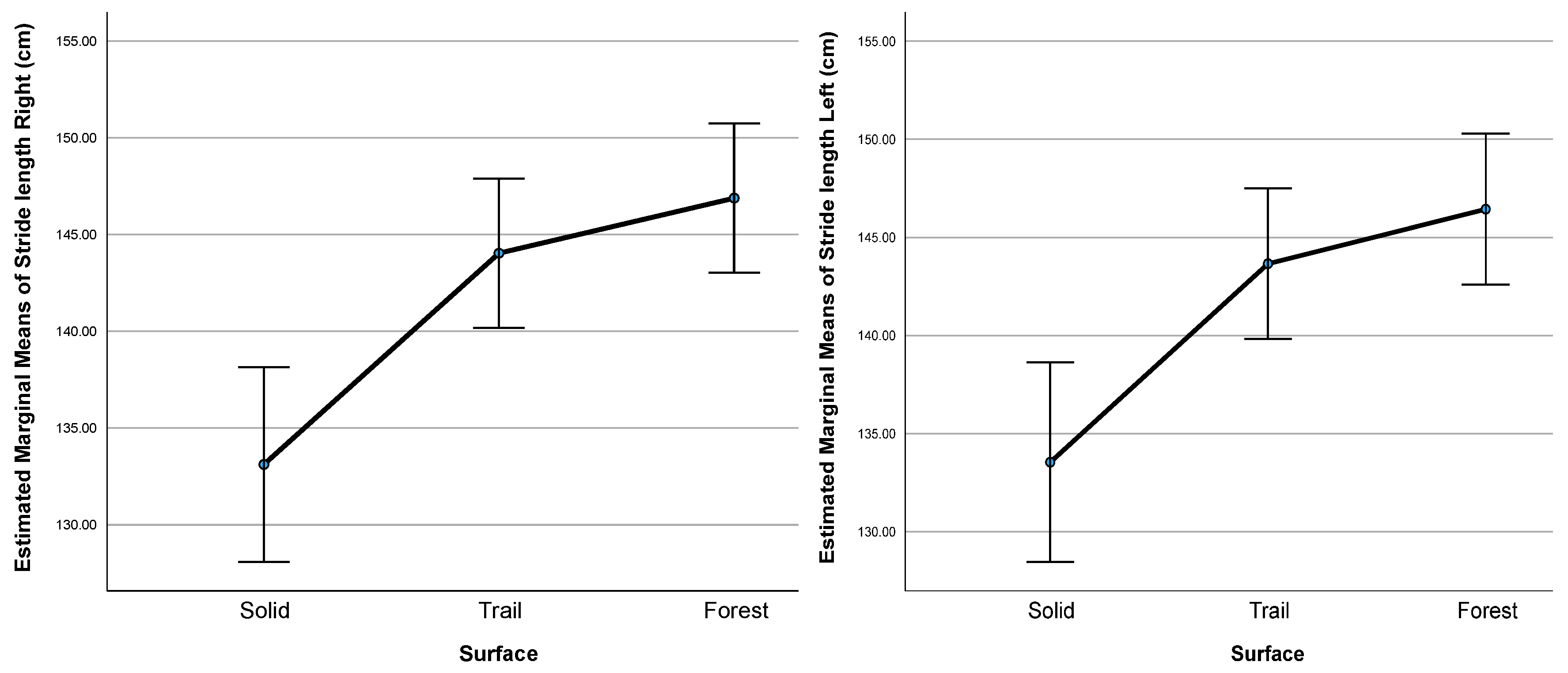
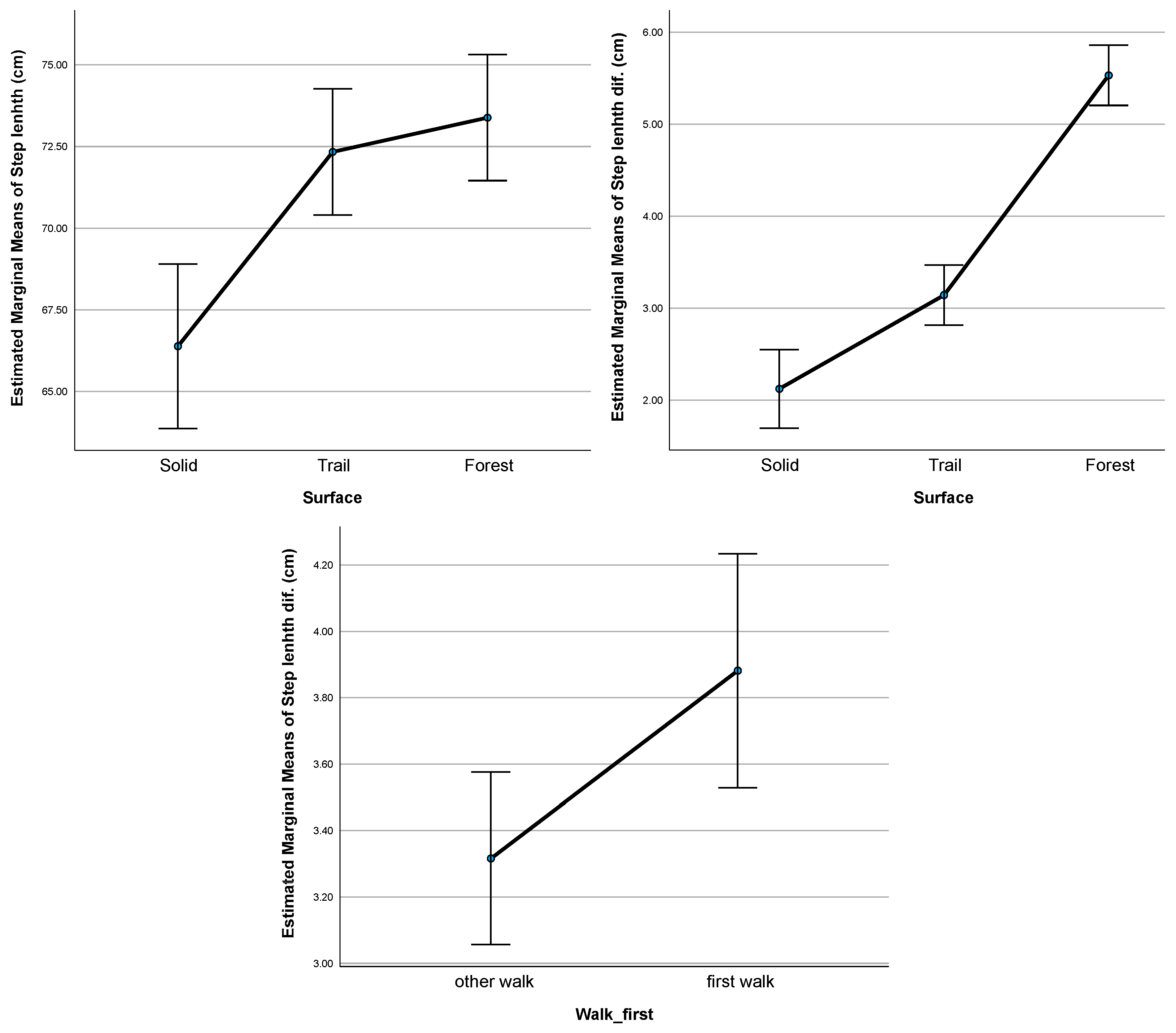
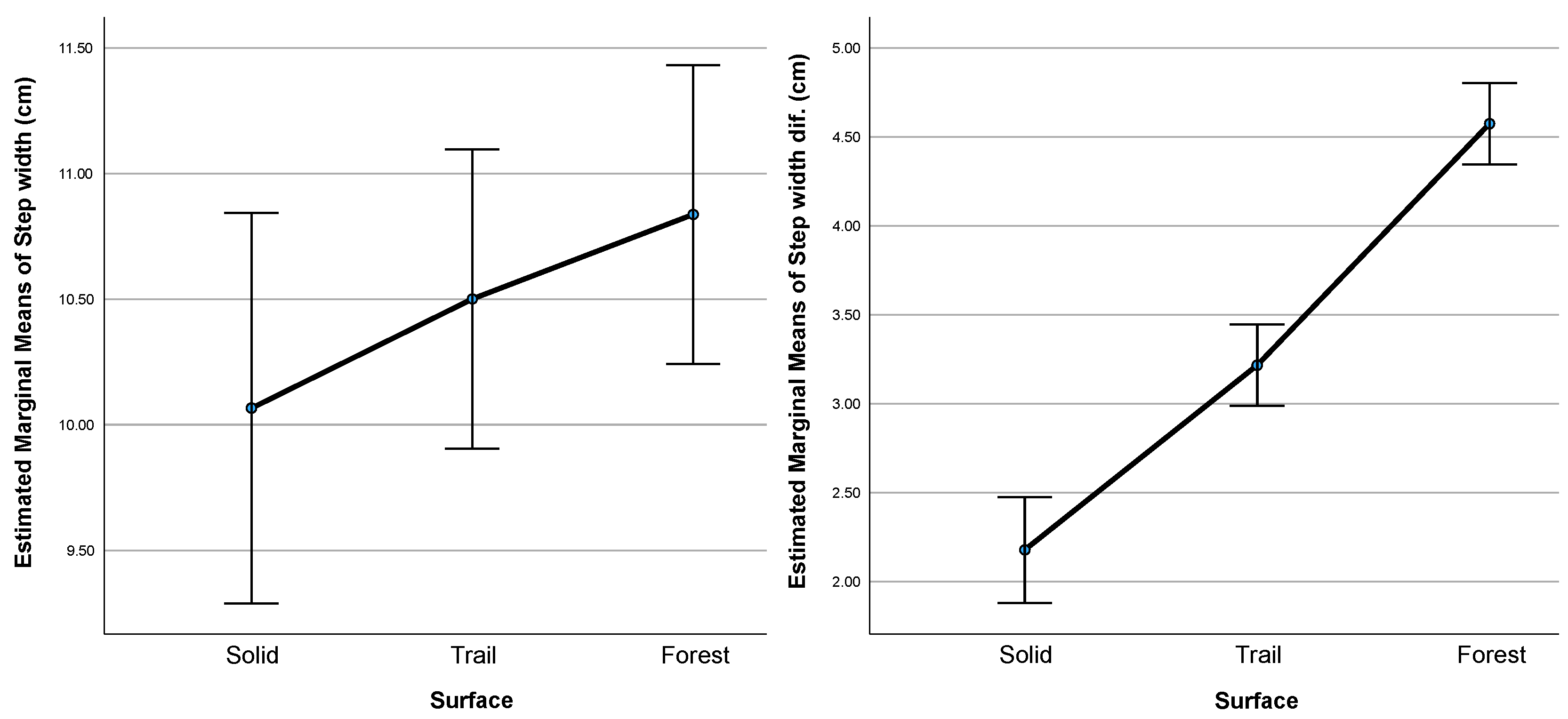
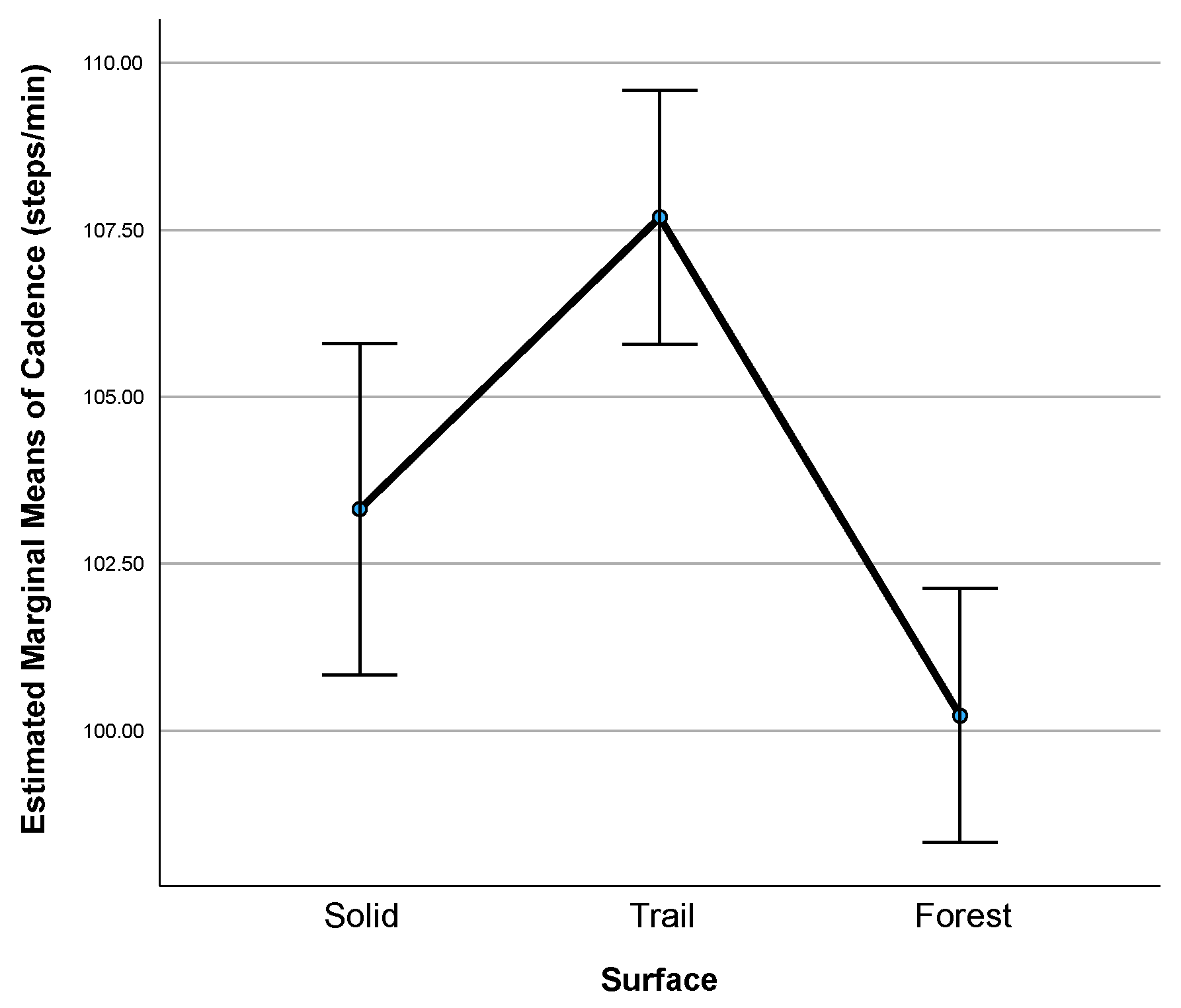
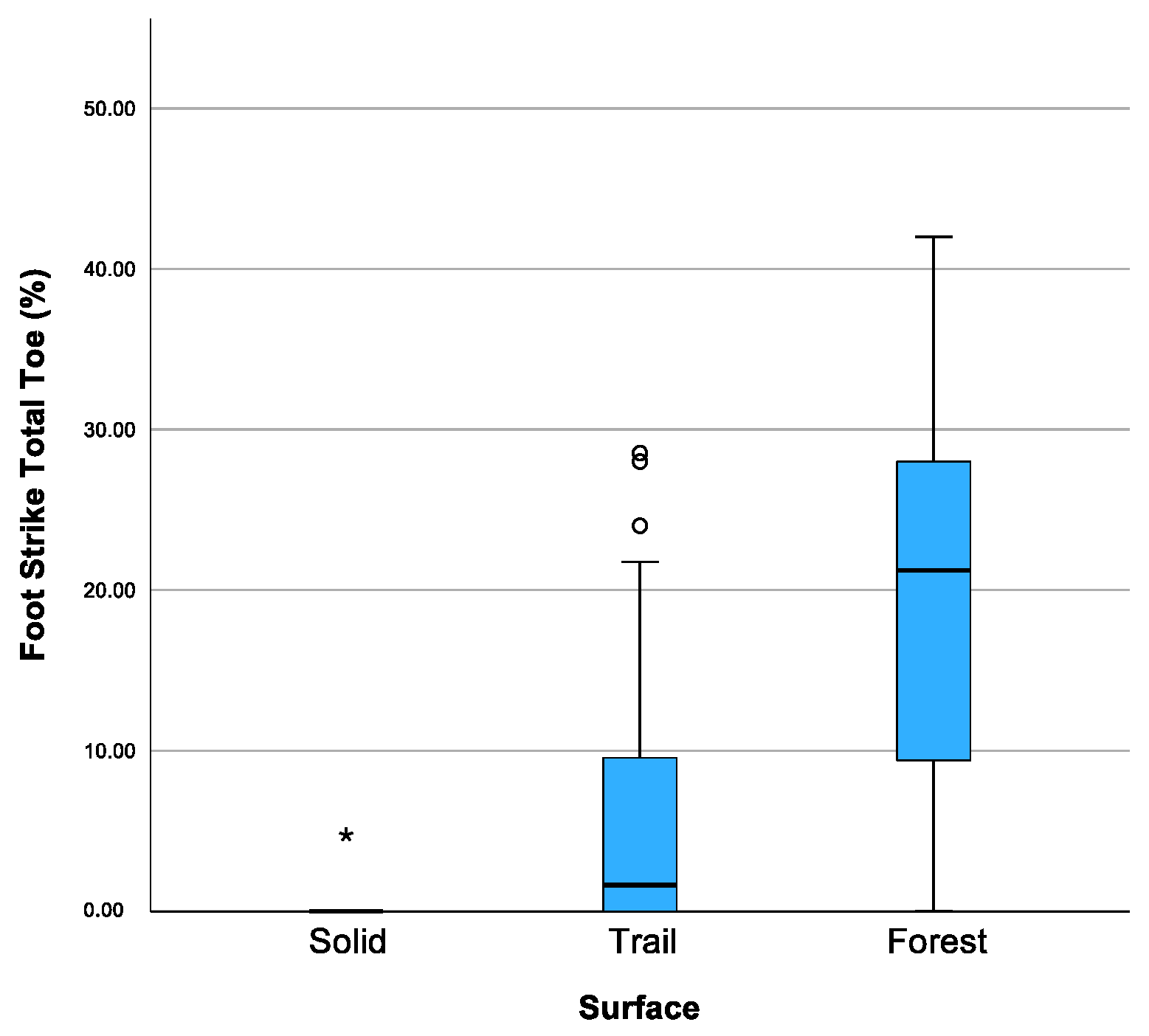
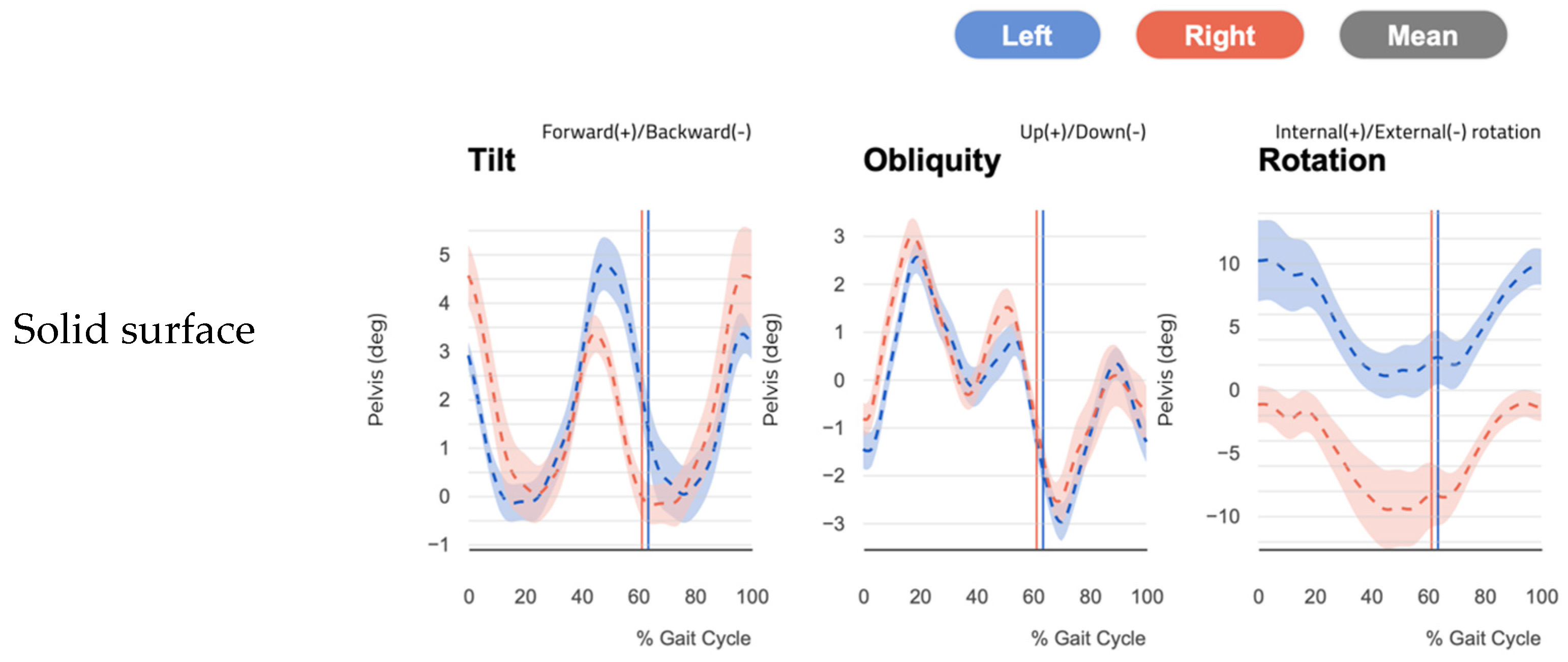
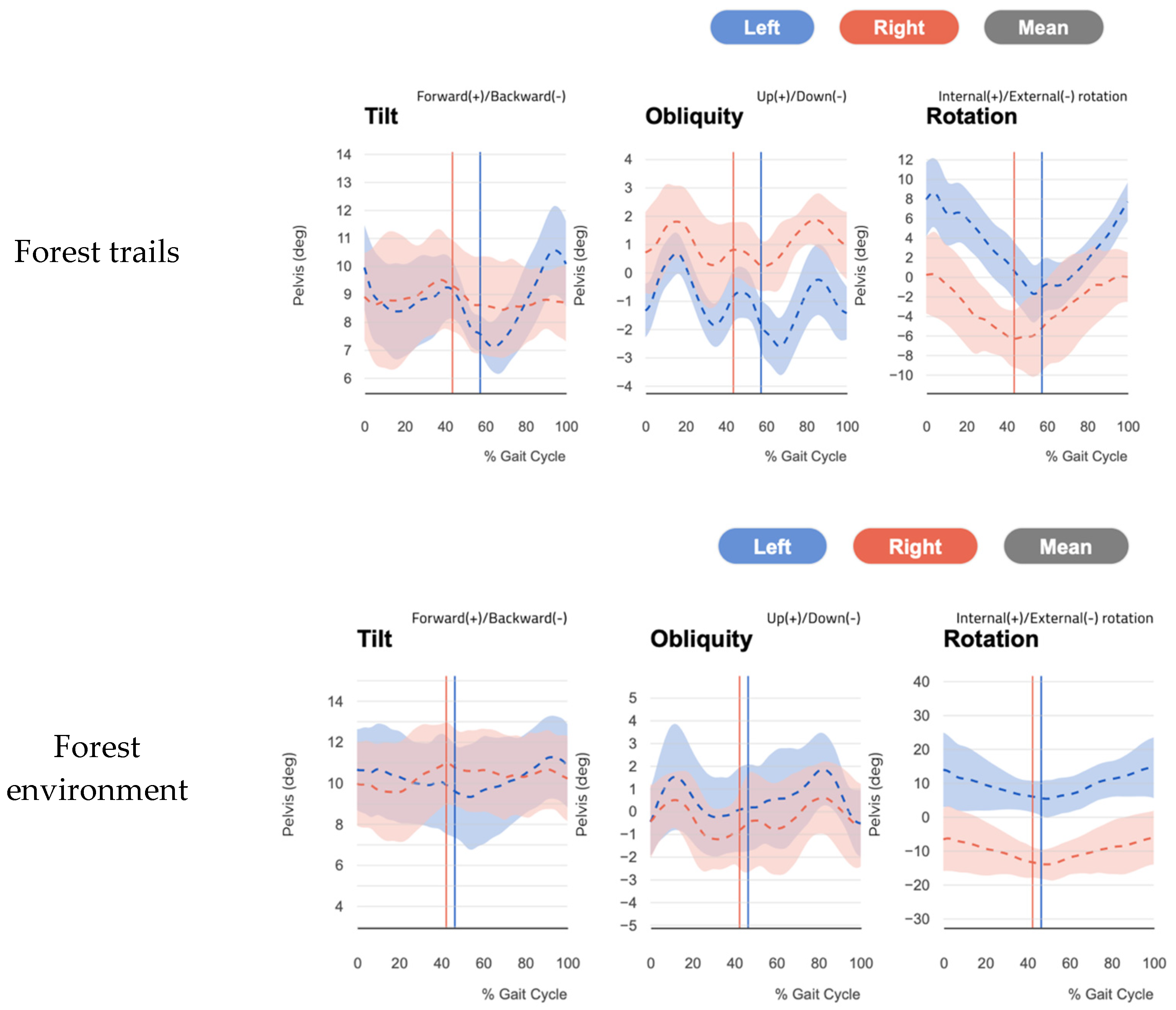

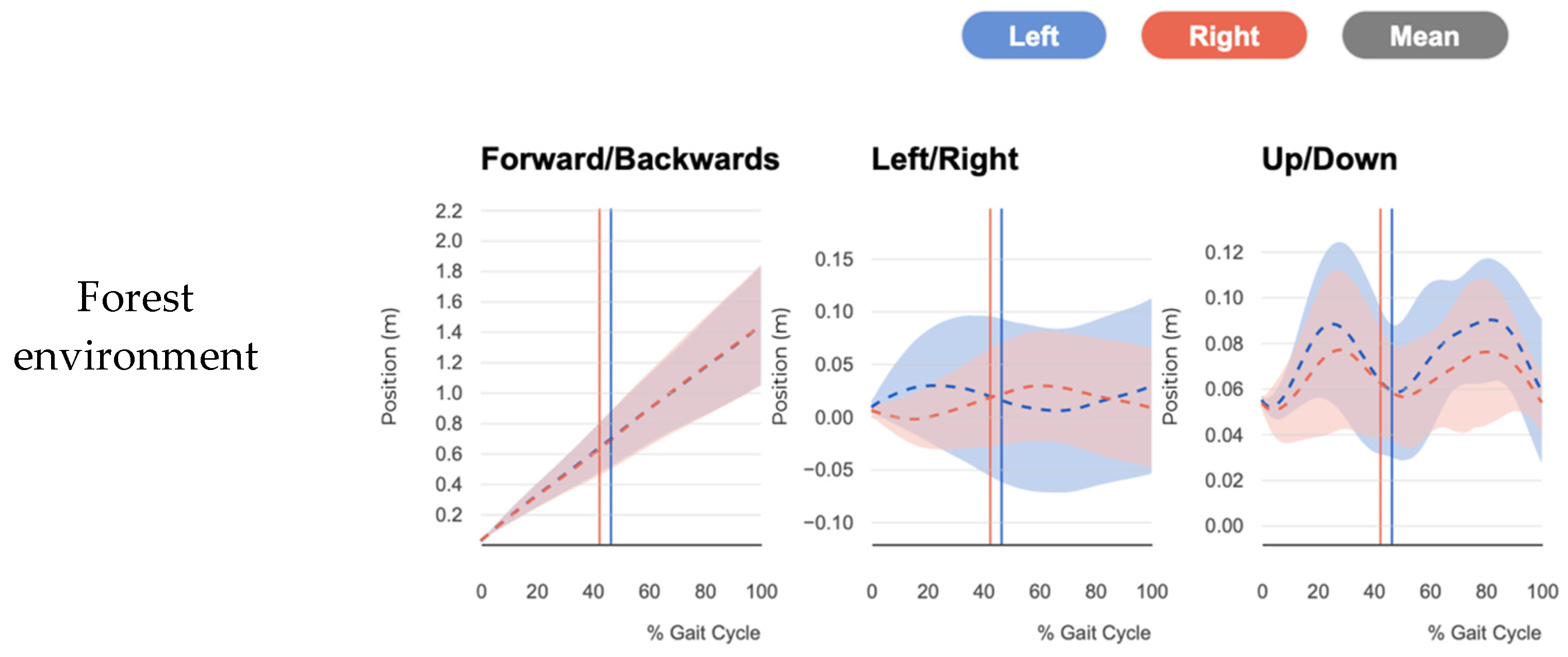
| Surface | Max. Length (m) | Number of Paths |
|---|---|---|
| Solid surfaces | 14 | There and back |
| Forest trails | 20 | There and back—2× |
| Forest environment | 20 | There and back—2× |
| Parameter | Values to Analyze | Min. | Max. | Mean | Standard Dev. |
|---|---|---|---|---|---|
| Number of participants | 15.00 | 15.00 | 15.00 | 15.00 | - |
| Number of Males | 10.00 | 10.00 | 10.00 | 10.00 | - |
| Number of Females | 5.00 | 5.00 | 5.00 | 5.00 | - |
| Total number of paths | 150.00 | 150.00 | 150.00 | 150.00 | - |
| Number of events by Male | 100.00 | 100.00 | 100.00 | 100.00 | - |
| Number of events by Female | 50.00 | 50.00 | 50.00 | 50.00 | - |
| Age (in years) | 15 | 19.0 | 57.0 | 38.3 | 12.79 |
| Height cm | 15 | 155.00 | 186.00 | 173.33 | 8.68 |
| Weight (kg) | 15 | 58.0 | 96,7 | 77.27 | 11.40 |
| BMI index | 15 | 22.9 | 30.3 | 25.58 | 2.09 |
| Shoe Size cm | 15 | 25.00 | 32.50 | 29.03 | 1.90 |
| Speed (m/s) | 150.00 | 0.87 | 1.61 | 1.19 | 0.17 |
| Cadence (steps/min) | 150.00 | 90.64 | 121.95 | 103.72 | 7.85 |
| Steps (Number of steps) | 3747.00 | 13.00 | 35.00 | 24.98 | 4.85 |
| Step Length Left (cm) | 10,766.44 | 56.00 | 102.42 | 71.78 | 9.09 |
| Step length Difference (cm) | 3747.00 | −9.32 | 16.27 | 4.49 | 4.99 |
| Step Length Right (cm) | 10,067.48 | 52.88 | 89.59 | 67.57 | 10.05 |
| Step width Left (cm) | 1644.74 | 4.24 | 16.53 | 10.96 | 2.33 |
| Step width Right (cm) | 1596.97 | 0.37 | 16.54 | 10.65 | 2.50 |
| Step width Difference (cm) | 3747.00 | −1.47 | 3.27 | 0.23 | 0.75 |
| Stride length Left (cm) | 1873.50 | 110.56 | 192.00 | 139.64 | 139.64 |
| Stride length Right (cm) | 1873.50 | 11.57 | 190.56 | 190.56 | 138.88 |
| Foot Strike Total Toe (%) | 150 | 0 | 42.00 | 10.12 | 11.49 |
| Foot Strike Total Heal (%) | 150 | 58.00 | 100 | 89.88 | 11.49 |
| Parameter/Factor | Type III Sum of Squares | df | Mean Square | F | Sig. |
|---|---|---|---|---|---|
| Cadence | (steps/min) | R2 | =0.298 | Adj R2 | =0.274 |
| Surface | 1679.704 | 2 | 839.852 | 18.784 | <0.001 |
| First walk | 6.236 | 1 | 6.236 | 0.139 | 0.709 |
| Gender | 0.084 | 1 | 0.084 | 0.002 | 0.966 |
| Shoe size | 452.858 | 1 | 452.858 | 10.129 | 0.002 |
| Step length | (cm) | R2 | =0.328 | Adj R2 | =0.305 |
| Surface | 992.496 | 2 | 496.248 | 10.787 | <0.001 |
| First walk | 28.399 | 1 | 28.399 | 0.617 | 0.433 |
| Gender | 1668.415 | 1 | 1668.415 | 36.268 | <0.001 |
| Shoe size | 2176.321 | 1 | 2176.321 | 47.309 | <0.001 |
| Step width | (cm) | R2 | =0.217 | Adj R2 | =0.190 |
| Surface | 11.691 | 2 | 5.845 | 1.334 | 0.267 |
| First walk | 6.788 | 1 | 6.788 | 1.549 | 0.215 |
| Gender | 63.022 | 1 | 63.022 | 14.384 | <0.001 |
| Shoe size | 154.003 | 1 | 154.003 | 35.149 | <0.001 |
| Step length difference | (cm) | R2 | =0.601 | Adj R2 | =0.587 |
| Surface | 283.345 | 2 | 141.673 | 107.456 | <0.001 |
| First walk | 9.595 | 1 | 9.595 | 7.278 | 0.008 |
| Gender | 0.118 | 1 | 0.118 | 0.089 | 0.765 |
| Shoe size | 0.278 | 1 | 0.278 | 0.211 | 0.647 |
| Step width difference | (cm) | R2 | =0.583 | Adj R2 | =0.569 |
| Surface | 122.688 | 2 | 61.344 | 95.059 | <0.001 |
| First walk | 0.332 | 1 | 0.332 | 0.515 | 0.474 |
| Gender | 2.214 | 1 | 2.214 | 3.431 | 0.066 |
| Shoe size | 0.008 | 1 | 0.008 | 0.012 | 0.912 |
| Stride length Left | (cm) | R2 | =0.318 | Adj R2 | =0.294 |
| Surface | 3162.137 | 2 | 1581.069 | 8.667 | <0.001 |
| First walk | 6.504 | 1 | 6.504 | 0.036 | 0.851 |
| Gender | 6603.512 | 1 | 6603.512 | 36.198 | <0.001 |
| Shoe size | 8661.377 | 1 | 8661.377 | 47.478 | <0.001 |
| Stride length Right | (cm) | R2 | =0.332 | Adj R2 | =0.309 |
| Surface | 3728.690 | 2 | 1864.345 | 10.145 | <0.001 |
| First walk | 27.280 | 1 | 27.280 | 0.148 | 0.701 |
| Gender | 7060.727 | 1 | 7060.727 | 38.422 | <0.001 |
| Shoe size | 9031.810 | 1 | 9031.810 | 49.148 | <0.001 |
| Stride length difference | (cm) | R2 | =0.090 | Adj R2 | =0.058 |
| Surface | 3.698 | 2 | 1.849 | 4.180 | 0.017 |
| First walk | 0.520 | 1 | 0.520 | 1.177 | 0.280 |
| Gender | 1.997 | 1 | 1.997 | 4.514 | 0.035 |
| Shoe size | 0.569 | 1 | 0.569 | 1.287 | 0.259 |
| Data Samples | Test Statistic | Std. Error | Std. Test Statistic | Sig. | Adj. Sig. a |
|---|---|---|---|---|---|
| Solid–Trail | −27.492 | 9.397 | −2.926 | 0.003 | 0.010 |
| Solid–Forest | −77.592 | 9.397 | −8.257 | <0.001 | 0.000 |
| Trail–Forest | −50.100 | 7.672 | −6.530 | <0.001 | 0.000 |
| Average Values | Surface | ||
|---|---|---|---|
| Solid Surface | Forest Trail | Forest Environment | |
| Steps (number of steps) | 19.63 | 24.70 | 27.93 |
| Duration (s) | 11.50 | 13.89 | 16.97 |
| Speed (m/s) | 1.10 | 1.24 | 1.17 |
| Cadence (steps/min) | 103.3 | 107.56 | 100.10 |
| Foot Strike Total Heal (%) | 99.68 | 94.28 | 80.59 |
| Foot Strike Total Toe (%) | 0.32 | 5.72 | 19.41 |
| Step width Difference (value in cm) | 0 | −0.06 | 0.63 |
| Step length Difference (value in cm) | 1.06 | 4.92 | 5.77 |
| Stride length Difference (value in cm) | 0.03 | 0.24 | −0.24 |
Disclaimer/Publisher’s Note: The statements, opinions and data contained in all publications are solely those of the individual author(s) and contributor(s) and not of MDPI and/or the editor(s). MDPI and/or the editor(s) disclaim responsibility for any injury to people or property resulting from any ideas, methods, instructions or products referred to in the content. |
© 2025 by the authors. Licensee MDPI, Basel, Switzerland. This article is an open access article distributed under the terms and conditions of the Creative Commons Attribution (CC BY) license (https://creativecommons.org/licenses/by/4.0/).
Share and Cite
Röhrich, M.; Abramuszkinová Pavlíková, E.; Šácha, J. Biomechanical Analysis of Gait in Forestry Environments: Implications for Movement Stability and Safety. Forests 2025, 16, 996. https://doi.org/10.3390/f16060996
Röhrich M, Abramuszkinová Pavlíková E, Šácha J. Biomechanical Analysis of Gait in Forestry Environments: Implications for Movement Stability and Safety. Forests. 2025; 16(6):996. https://doi.org/10.3390/f16060996
Chicago/Turabian StyleRöhrich, Martin, Eva Abramuszkinová Pavlíková, and Jakub Šácha. 2025. "Biomechanical Analysis of Gait in Forestry Environments: Implications for Movement Stability and Safety" Forests 16, no. 6: 996. https://doi.org/10.3390/f16060996
APA StyleRöhrich, M., Abramuszkinová Pavlíková, E., & Šácha, J. (2025). Biomechanical Analysis of Gait in Forestry Environments: Implications for Movement Stability and Safety. Forests, 16(6), 996. https://doi.org/10.3390/f16060996





